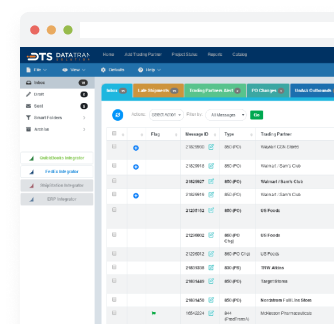EDI Industry Definitions
Learn more about the EDI industry terminology and definitions by EDI experts, DataTrans Solutions.
With over 20 years of experience and counting, DataTrans team of experts has continued to support companies around the globe enabling our customers to connect, integrate, automate and expand their business.
Partner with DataTrans For An All-In-One Multichannel Solution
- Affordable, simple, easy to use, scalable cloud-based EDI and eCommerce solution
- Easily process EDI transactions and fulfill orders
- Connect to all your trading partners through WebEDI and maintain 100% EDI compliance with your entire network
- Scalable portal that integrates with any application
Learn more about EDI Industry Terminology
- ANSI: (American National Standards Institute) – “…administers and coordinates the U.S. voluntary standardization and conformity assessment system.” ANSI ASC X12 is the official designation of the U.S. national standards body for the development and maintenance of Electronic Data Interchange (EDI) standards. ASCII X12 has been accredited by ANSI since 1979.
- AS1: (Applicability Statement 1) – A specification for EDI communications between two businesses using e-mail protocols. The standard provides S/MIME (Secure Multi-Purpose Internet Mail Extensions) and uses Simple Mail Transfer Protocol (SMTP) to transmit data. An Internet connection capable of sending and receiving e-mail, an EDI transfer engine, and digital certificates are required for data exchange using AS1. Almost any type of data can be transmitted.
- AS2: (Applicability Statement 2) – Has largely superseded AS1, it specifies how to connect, deliver, validate and acknowledge data, and creates an envelope for a message which is then sent securely over the Internet. An implementation of AS2 involves two machines, a client and a server, communicating with each other over the Internet using HTTP protocol.
- AS3: (Applicability Statement 3) – A communications method that uses FTP/S to send EDI transactions over the Internet.
- ASN: (Advance Ship Notice or 856) – An EDI formatted electronic notification of pending deliveries. The goal of the ASN is to provide information to the destination’s receiving operations in advance of delivery.
- B2B: (Business-to-Business) – Electronic commerce transactions between businesses, as opposed to those between businesses and other groups such as consumers.
- Cloud Infrastructure: Web-based processing, whereby shared resources, software, and information are provided to computers and other devices (such as smartphones) on demand over the Internet.
- CRM (Customer Relationship Management) – Helps companies acquire and retain customers, gain deep marketing and customer insight, and align organization on customer-focused strategies
- CSV: (Comma-Separated Values) – A file type that stores tabular data, one implementation of a delimited text file, which uses a comma to separate values.
- Data Element: The basic unit of information in the EDI standards containing a set of values that represent a singular fact. For every piece of information on a paper document, there is generally a corresponding data element in the electronic document or transaction set. Data elements are the pieces that make up data segments.
- Data Segment: An intermediate unit of information in a transaction set. A segment consists of logically related data elements in a defined sequence: a predetermined segment identifier, one or more data elements, and a segment terminator. A data segment is normally one line of ANSI X12 code.
- Delimiter: A character that identifies the beginning or the end of a character string or specifies the boundary between separate, independent regions in a data stream. For example, a comma-separated values (CSV) file is one in which each value in the cells of a table row is separated from the next value by a comma.
- Digital Certificate: Establishes your credentials when doing business or other transactions on the Web. Basically, it acts as a digital “credit card” and is issued by a certificate authority, which also manages security credentials and public keys for message encryption. The certificate contains your name, a serial number, expiration date, a copy of the certificate holder’s public key, and the digital signature of the certificate-issuing authority so that a recipient can verify that the certificate is real.
- DISA: (Data Interchange Standards Association) – Serves as the Secretariat for ASC X12 and their X12 EDI and XML standards development process.
- DUNS Number: A nine-digit number assigned by Dun and Bradstreet to uniquely identify business entities. This number is commonly used as an EDI identification number using a qualifier of 01.
- EDI: (Electronic Data Interchange) The computer-to-computer exchange of business documents or business information in a structured or standard format. An EDI message contains a string of data elements, each of which represents a singular fact, such as a price, product model number, and so forth, separated by a delimiter. The entire string is called a data segment. One or more data segments framed by a header and trailer form a transaction set, which is the EDI unit of transmission. A transaction set often consists of what would usually be contained in a typical business document or form. The parties who exchange EDI transmissions are referred to as trading partners.
- EDIFACT: (Electronic Data Interchange For Administration, Commerce, and Transport) is the international EDI standard developed under the United Nations. The EDIFACT standard provides messages which allow multi-country and multi-industry exchange.
- Electronic Envelope: Electronic information that binds together a set of transmitted documents sent from one sender to one receiver. There are three types of envelopes, the ISA/IEA, or transmission envelope, the GS/GE envelope, and the ST/SE envelope.
- ERP: (Enterprise Resource Planning) systems integrate all data and processes of an organization into a unified system. The term was originally derived from manufacturing resource planning (MRP). MRP evolved into ERP when “routings” became a major part of the software architecture and a company’s capacity planning activity also became a part of the standard software activity. ERPs are cross-functional and enterprise wide. ERP systems typically handle the manufacturing, logistics, distribution, inventory, shipping, invoicing, and accounting for a company. ERP software can also aid in the control of many business activities, like sales, marketing, delivery, billing, production, inventory management, quality management, and human resource management.
- Flat File: Computer file that is usually read or written sequentially; a fixed-field, fixed-record-length application data file. Flat files are still widely used for data transmission because they are compact and support high performance operations.
- FTP: (File Transfer Protocol) – Used to transfer data from one computer to another over the Internet, or through a network. FTP is a commonly used protocol for exchanging files over any TCP/IP based network to manipulate files on another computer on that network regardless of which operating systems are involved.
- FTP SSL: (File Transfer Protocol over Secure Sockets Layer) – allows sessions to be encrypted between an FTP client and server.
- Functional Acknowledgement: (997) – Provides for an EDI notification by the ultimate receiver that the sender’s EDI transmission has been received.
- GS/GE: (Functional Group Segments) – These segments comprise the Functional Group envelope. It contains information such as the type of transaction enclosed, the sender and receiver information, and defines the version, transmission date and control number.
- HIPAA: (Health Insurance Portability and Accountability Act) – Part of the HIPAA initiative seeks to establish standardized mechanisms for electronic data interchange (EDI), security, and confidentiality of all healthcare-related data.
- HTTP: (Hypertext Transfer Protocol) – A communications protocol used to transfer information on intranets and the World Wide Web, or a request/response protocol between a client and a server.
- Hub: Often a large customer working with “spokes” that are its suppliers. The hub partner normally establishes the requirements of which EDI documents it sends and receives. The suppliers, or vendors, are then required to implement an EDI solution in order to do business with that particular trading partner.
- ISA/IEA: (Interchange Control Segments) – The outer envelope known as the Interchange Envelope. It contains information on the number of transaction sets included, identifies the sender and receiver, and provides date and time of the transmission.
- Mapping: The process of creating data element mappings between two distinct data models; used as a first step for a wide variety of data integration tasks. For example, a company that would like to transmit and receive purchase orders and invoices with other companies might use it to create data maps from a company’s data to standardized ANSI ASC X12 messages.
- MSMQ: (Microsoft Message Queuing) – A messaging protocol that allows applications running on disparate servers to communicate in a failsafe manner. MSMQ can be used to provide secure, reliable transport with a unified programming model compatible with other communications standards.
- ODBC: (Open Database Connectivity) – Provides a standard software API (application programming interface) method for using database management systems, independent of programming languages, database systems, and operating systems.
- OLE DB: (Object Linking and Embedding, Database) – An AP interface designed by Microsoft for accessing different types of data stores in a uniform manner. It separates the data store from the application that needs access to it through a set of abstractions that include the datasource, session, command and rowsets
- Qualifier: A data element taken from a list of approved codes that identifies or defines a related element, set of elements or a segment in an EDI transaction set.
- RFP: (Request for Proposal) – An invitation for suppliers, through a bidding process, to submit a proposal on a specific commodity or service.
- SCM: (Supply Chain Management) – Helps companies enhance operational flexibility across global enterprises and provide real-time visibility for customers and suppliers.
- SFTP: (Secure File Transfer Protocol) – A network protocol that provides file transfer and manipulation functionality over any reliable data stream. It is typically used with the SSH-2 protocol to provide secure file transfer.
- SMTP: (Simple Mail Transfer Protocol) – The de facto standard for e-mail transmissions across the Internet, a relatively simple, text-based protocol in which one or more recipients of a message are specified.
- SRM: (Supplier Relationship Management) – Customers can collaborate closely with suppliers and integrate sourcing processes with applications throughout the enterprise to enhance transparency and lower costs.
- SSCC: (Serial Shipping Container Code) – the GS1 Identification Key for an item established for transport and/or storage which needs to be managed through the supply chain. The SSCC is assigned for the lifetime of the transport item and is a mandatory element on the UCC-128 Shipping Label.
- ST/SE: (Segment Terminator) – These segments indicate the beginning and the end of a singular transaction and are therefore referred to as the Transaction envelope. They include information such as the number of segments in the transaction set to ensure complete transmission.
- Trading Partner: A person or organization that has agreed to exchange EDI business documents electronically. The sending or receiving party involved in the exchange of EDI transmissions.
- Transaction Sets: X12 standards identify a series of basic electronic documents called transaction sets. These cover common business documents such as purchase orders, invoices, and manifests but also specialized single-industry documents such as those for government or health care use.
- Translation: Conversion of business application data to and from another data format, such as a standard (ASC X12 for example) using translation software and maps.
- UCC-128 Shipping Label: A UCC-128 label contains information such as the SSCC (Serial Shipping Container Code), barcodes, the origin and destination of the package and its contents. The label is used on both pallet shipments and individual cartons of product. Many times used in conjunction with ASNs (856 transaction sets).
- VAN: (Value Added Network) A third party network that acts as an intermediary between trading partners, and is responsible for routing, storing and delivering EDI messages. VAN’s typically support multiple data communications protocols and interconnect with other VAN’s to allow for almost ubiquitous transmission capabilities between trading partners.
- VBScript: (Visual Basic Scripting Edition) – a language to write functions that are embedded in or included from HTML pages and interact with the Document Object Model (DOM) of the page, to perform tasks not possible in HTML alone.
- X12: (also known as ANSI ASC X12) The official designation of the U.S. national standards body for the development and maintenance of EDI standards. The most widely used standard for EDI in the United States and much of North America.
- XML: (Extensible Markup Language) is a flexible way to create common information formats and share both the format and the data on the World Wide Web. XML can be used by any individual or group of individuals or companies that wants to share information in a consistent way.
What is EDI?
Learn more about EDI, EDI transactions, how it works & how it can help your business
talk to an expert
What is EDI
EDI stands for electronic data interchange and is defined as computer-to-computer exchange of business information in a standard and structured format.

EDI Transactions
DataTrans supports all industries and all EDI documents. Specializing in supporting your company for all your EDI transactions, needs, and requirements.
How to Get Started With EDI
DataTrans all-in-one multichannel EDI and eCommerce solutions, WebEDI, provides a simple and affordable way to become EDI capable and compliant within minutes to all your trading partners. Simplify the procurement process with WebEDI to easily manage EDI transactions, process and prepare orders and efficiently fulfill shipments with WebEDI. How does it work? Simple, view our video or contact us for more information.
- Cloud-based multichannel EDI and eCommerce solution: affordable, simple, easy to use, scalable
- Efficiently manage activity, process transactions and fulfill orders all within WebEDI
- Connect to all your retailers, eCommerce partners, grocers, OEMs, healthcare companies and trading partners on one portal
- Easy EDI compliance with your entire network
Scalable portal that integrates with any shipping service, accounting program, eCommerce marketplace, ERP, WMS, 3PL and more

PARTNER WITH DATATRANS SOLUTIONS TO
Connect, Integrate, Automate & Expand Your Business
CONNECT
Connect to your network of trading partners
Fulfill
Fulfill orders faster and on time
Automate
Streamline your order fulfillment process`
EXPAND
Leverage your EDI capabilities to expand your network of partners
accuracy
Elimination of rekeying errors mitigating charge backs
COMMUNICATE
Receive and respond in minutes
Efficiency
EDI improves the overall order processing
Connect
Connect With ANY Trading Partner
DataTrans is the leading EDI provider that maintains connections with thousands of companies allowing users to easily manage activity within our cloud-based EDI portal, WebEDI. We are constantly adding new companies to our network and we try to keep this list as current as possible. View a few of our trading partners below. For more information select below to find your trading partner and connect today.














